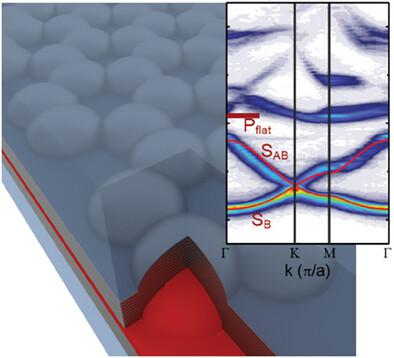Our official English website, www.x-mol.net, welcomes your feedback! (Note: you will need to create a separate account there.)
Dirac Cones and Room Temperature Polariton Lasing Evidenced in an Organic Honeycomb Lattice
Advanced Science ( IF 15.1 ) Pub Date : 2024-04-12 , DOI: 10.1002/advs.202400672 Simon Betzold 1 , Johannes Düreth 1 , Marco Dusel 1 , Monika Emmerling 1 , Antonina Bieganowska 2 , Jürgen Ohmer 3 , Utz Fischer 3 , Sven Höfling 1 , Sebastian Klembt 1
Advanced Science ( IF 15.1 ) Pub Date : 2024-04-12 , DOI: 10.1002/advs.202400672 Simon Betzold 1 , Johannes Düreth 1 , Marco Dusel 1 , Monika Emmerling 1 , Antonina Bieganowska 2 , Jürgen Ohmer 3 , Utz Fischer 3 , Sven Höfling 1 , Sebastian Klembt 1
Affiliation

|
Artificial 1D and 2D lattices have emerged as a powerful platform for the emulation of lattice Hamiltonians, the fundamental study of collective many‐body effects, and phenomena arising from non‐trivial topology. Exciton‐polaritons, bosonic part‐light and part‐matter quasiparticles, combine pronounced nonlinearities with the possibility of on‐chip implementation. In this context, organic semiconductors embedded in microcavities have proven to be versatile candidates to study nonlinear many‐body physics and bosonic condensation, and in contrast to most inorganic systems, they allow the use at ambient conditions since they host ultra‐stable Frenkel excitons. A well‐controlled, high‐quality optical lattice is implemented that accommodates light‐matter quasiparticles. The realized polariton graphene presents with excellent cavity quality factors, showing distinct signatures of Dirac cone and flatband dispersions as well as polariton lasing at room temperature. This is realized by filling coupled dielectric microcavities with the fluorescent protein mCherry. The emergence of a coherent polariton condensate at ambient conditions are demonstrated, taking advantage of coupling conditions as precise and controllable as in state‐of‐the‐art inorganic semiconductor‐based systems, without the limitations of e.g. lattice matching in epitaxial growth. This progress allows straightforward extension to more complex systems, such as the study of topological phenomena in 2D lattices including topological lasers and non‐Hermitian optics.
中文翻译:

有机蜂窝晶格中的狄拉克锥体和室温极化激元激光
人工一维和二维晶格已成为模拟晶格哈密顿量、集体多体效应的基础研究以及非平凡拓扑产生的现象的强大平台。激子极化子、玻色子部分光和部分物质准粒子将明显的非线性与片上实现的可能性结合起来。在这种情况下,嵌入微腔中的有机半导体已被证明是研究非线性多体物理和玻色子凝聚的通用候选者,与大多数无机系统相比,它们允许在环境条件下使用,因为它们具有超稳定的弗伦克尔激子。实现了一个控制良好的高质量光学晶格,可容纳光物质准粒子。所实现的极化子石墨烯具有优异的腔品质因数,显示出狄拉克锥和平带色散以及室温下极化子激光的独特特征。这是通过用荧光蛋白 mCherry 填充耦合介电微腔来实现的。证明了在环境条件下出现相干极化子凝聚体,利用与最先进的基于无机半导体的系统一样精确和可控的耦合条件,而不受外延生长中晶格匹配等限制。这一进展可以直接扩展到更复杂的系统,例如二维晶格中拓扑现象的研究,包括拓扑激光器和非厄米光学。
更新日期:2024-04-12
中文翻译:

有机蜂窝晶格中的狄拉克锥体和室温极化激元激光
人工一维和二维晶格已成为模拟晶格哈密顿量、集体多体效应的基础研究以及非平凡拓扑产生的现象的强大平台。激子极化子、玻色子部分光和部分物质准粒子将明显的非线性与片上实现的可能性结合起来。在这种情况下,嵌入微腔中的有机半导体已被证明是研究非线性多体物理和玻色子凝聚的通用候选者,与大多数无机系统相比,它们允许在环境条件下使用,因为它们具有超稳定的弗伦克尔激子。实现了一个控制良好的高质量光学晶格,可容纳光物质准粒子。所实现的极化子石墨烯具有优异的腔品质因数,显示出狄拉克锥和平带色散以及室温下极化子激光的独特特征。这是通过用荧光蛋白 mCherry 填充耦合介电微腔来实现的。证明了在环境条件下出现相干极化子凝聚体,利用与最先进的基于无机半导体的系统一样精确和可控的耦合条件,而不受外延生长中晶格匹配等限制。这一进展可以直接扩展到更复杂的系统,例如二维晶格中拓扑现象的研究,包括拓扑激光器和非厄米光学。



























 京公网安备 11010802027423号
京公网安备 11010802027423号